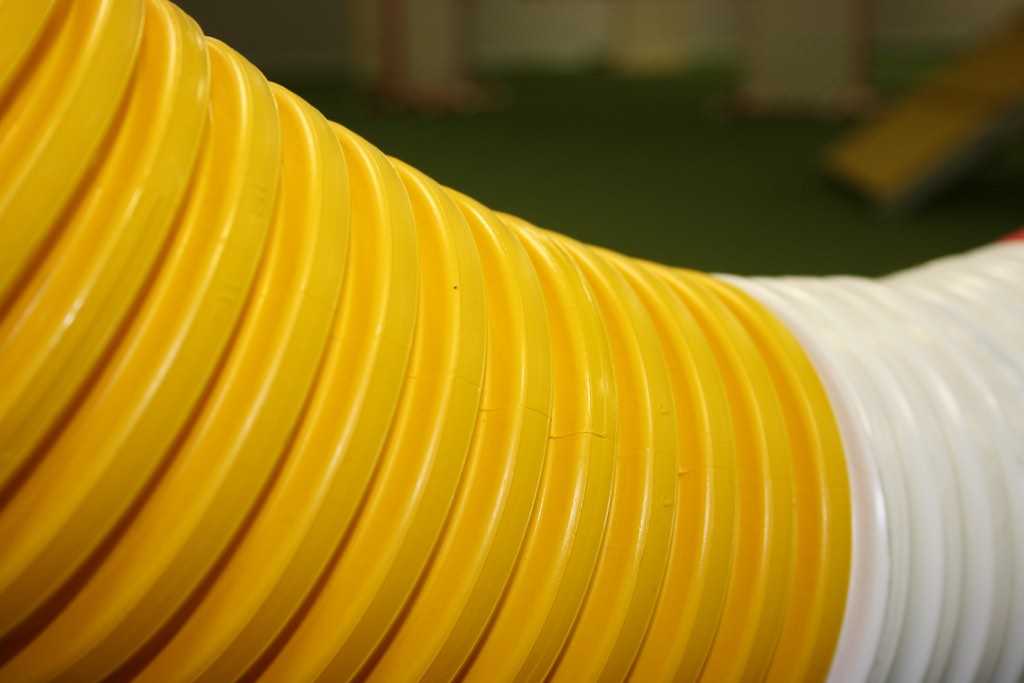Learning the Post Turn
03 Feb 2006
The Post Turn is one of the basic agility handling manuevers. It is an extension of the obedience healing we all learned in basic dog obedience class. I’ve put together an overly thorough method for training the Post Turn to give new trainers a feel for Operant Conditioning that can be used for training other dog behaviors.
Like all handling manuevers the Post Turn is best learned and mastered On The Flat before adding any obstacles. My approach is to initially lure the dog through the Post Turn and then quickly switch to rewarding the dog for success. I’ll be using treats because they work well for Milo, he likes them and he still thinks when I use them, unlike his tennis ball which gets him “unhealthily excited”. You should use what works best for your dog.
Initiating the Behavior
Start in a safe location with no distractions. It is easiest to work without a leash, it is one less thing for you to keep track of and, more importantly, you don’t want to accidentally correct your dog by yanking or stepping on the leash. When luring you hold onto the treat(toy) with your arm near your body and at a height where your dog is keenly attentive to it. I like to have the dog standing at the start of the exercise, some dogs who are sitting or lying down won’t get up when you start moving.
Only when you have your dog’s attention start rotating slowly. For now always rotate in the same direction. By rotate I mean to take small steps in a circle 1-2 feet in diameter. Let your dog see/smell the treat(toy) throughout the exercise. Some dogs will pick up on this manuever better if you rotate in a larger circle. You may have to play with this a little.
One reason I like to use treats is that I can dole them out quickly during the turn to keep the dog’s attention. Try to make a couple complete rotations with 2-4 cookies per rotation. If your dog is “getting it” you can reduce the lure down to 1-2 cookies per rotation. Get down to one cookie per rotation. You only want to lure the dog about a half dozen times at most before trying the next step. The little video below shows me luring Milo through the Post Turn first with two cookies per rotation and then only one per rotation.
| Luring Through the Post Turn | |
|---|---|
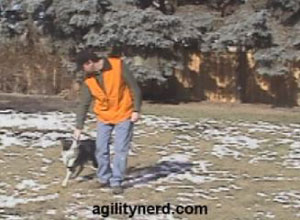 | 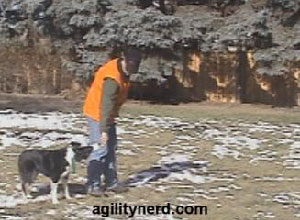 |
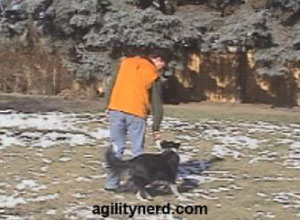 | 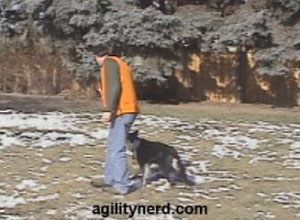 |
Rewarding
Now for the moment of truth: changing from luring to rewarding. Show your dog you don’t have a cookie(toy) in your hand (but have some quickly accessible and hidden in your other hand) and start the rotation. With luck they will follow your lead and start to follow you. Make a fuss and reward your dog with the cookie or the toy. Your dog just trusted you that you’d deliver the reward. Your rotating motion has started to become a cue for your dog to follow you through the turn. I haven’t yet found a need for a verbal cue for the Post Turn.
Variable Reinforcement
Once your dog follows you consistently through the Post Turn with only a reward at the end over a number of training sessions you can switch to rewarding on a Reinforcement Schedule where you might only give the treat/toy half the time or down to a quarter of the times. The other times you should give a very happy “good boy” and/or a head rub: a non-food/toy reward (so you really are rewarding 100% of the time, just not always with a high value reward).
Raising the Bar/Criteria
My understanding is that dogs don’t generalize concepts particularly well (which makes me think they might not be learning the general concepts we think we are training them). So just because your dog can perform a Post Turn off leash next to you in your backyard without distractions doesn’t mean your dog will perform a Post Turn off leash at your next agility class. So as a trainer you have to take the time to train each of these dimensions (individually) before you can be confident that your dog truly understands the behavior. There are a few dimensions in which we can increase the difficulty of this task:
- Post Turn in the opposite direction
- Post Turn faster
- Add increasing distractions (favorite toys on the field, a friendly dog sitting nearby, etc.)
- Location (inside, in the backyard, inside at your club, outside at your club, in the park, etc.)
- Post Turn approaching an obstacle
- Post Turn following an obstacle
- Post Turn with the dog further from your body
Change these dimensions one at a time and possibly only a little at a time. Since these changes increase the difficulty (raise the criteria) you will want to increase the food/toy rewards especially if your dog is having trouble completing the behavior with the same comfort/desire.
Troubleshooting - Breaking Down Behaviors
When you switch from luring to rewarding your dog may not work without the cookie(toy) visible. If so go back and do a quick lured rotation. Then try a partial rotation without the treat(toy) and wait for your dog to take a step in the direction of your rotation. You may have to wait a while (even tens of seconds) but don’t give up. Reward your dog with the hidden cookie when they take the first step(s).
If your dog stays standing and doesn’t move even after waiting you can try using a verbal lure. Make a “kissy” noise, clapping, etc to get your dog moving. Once the dog starts moving you can reward with the hidden treat.
Once your dog is moving without a lure (treat, toy, or verbal) then increase the distance they have to follow before you give the hidden reward. Build up to a 360 degree rotation before you give the reward.
Post Turn Faster
As you move more quickly never let the dog anticipate the destination of the turn and cut behind you. In the clip below I had to turn pretty abruptly to get Milo to cut behind me, but he still shouldn’t have done it. When he did I gave him his No Reward Marker (NRM), a happy “oops”, and we tried again. He got a “good boy” and a cookie on the next try (which I guaranteed was successful). Then I sped up again and he followed without cutting behind.
For some dogs an No Reward Marker is too stressful and you are better off just not rewarding and starting the exercise over.
Increase the Post Turn Diameter
Use your arm to push your dog further away from your body. Reward on the dog’s line (instead of always bringing the dog into you as I show in the video below):
Quit Early and On a High Note
Don’t over do it in any of your training sessions. Some dogs will get the basic concept in a few tries. Others may take a number of sessions just to get a started. You want to keep the training sessions very short (only a couple minutes) and always end on a success. If you have to simplify the exercise to get a success then do so and quit. If in doubt quit early! You want your dog to end the session still eager to try again.
The Training Process in Review
So here are the steps we just went through in training the Post Turn:
- Plan the behavior(s) and control your environment
- Initiate the behavior
- Reward the behavior
- Reinforce the behavior
- Raise the criteria - start over at step 1
You can apply these steps to training any behavior. You’ll also find that you can use other variants of this approach like Shaping and/or Clicker Training as part of your toolbox for teaching agility behaviors. Every trainer has their own philosophy on when to use any technique. As you learn more about dog training for agility you can develop your own methodology.
If you enjoyed this article won't you please:  Thanks!
Thanks!
